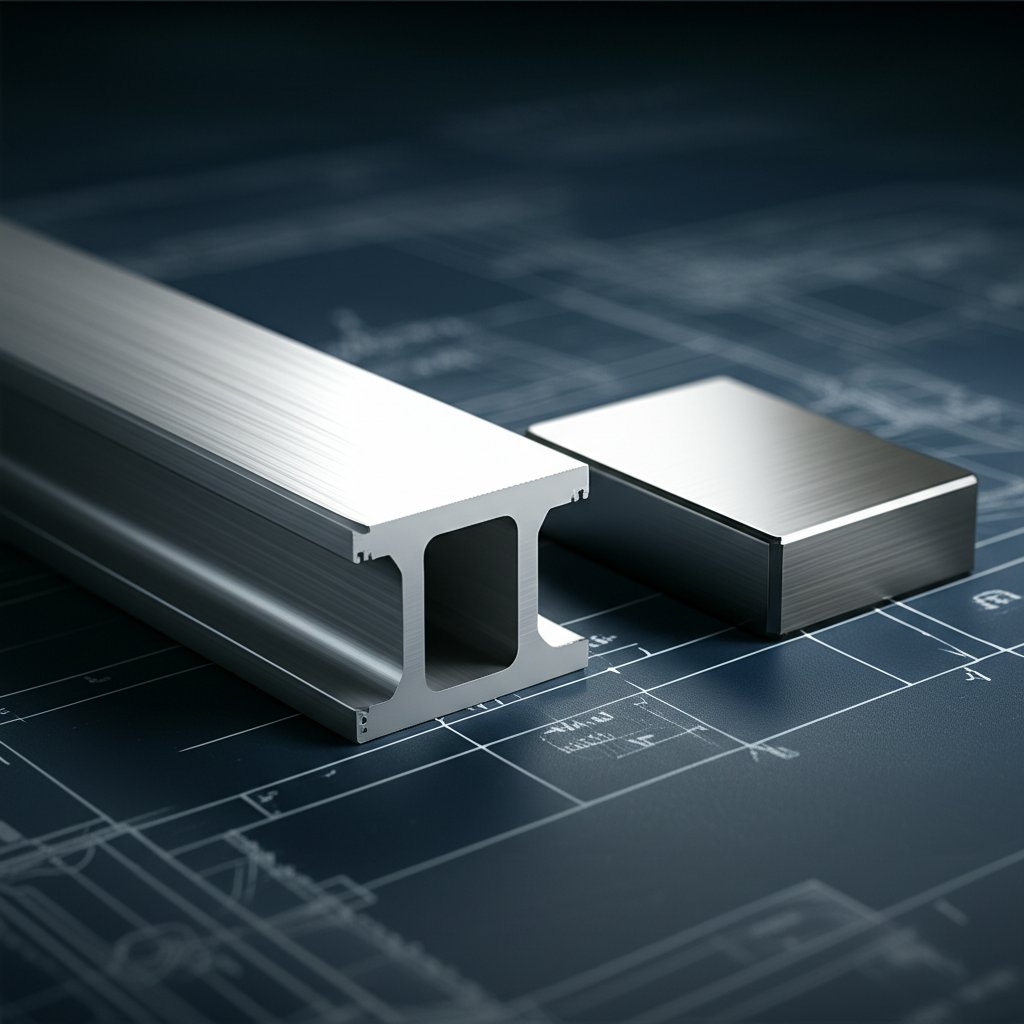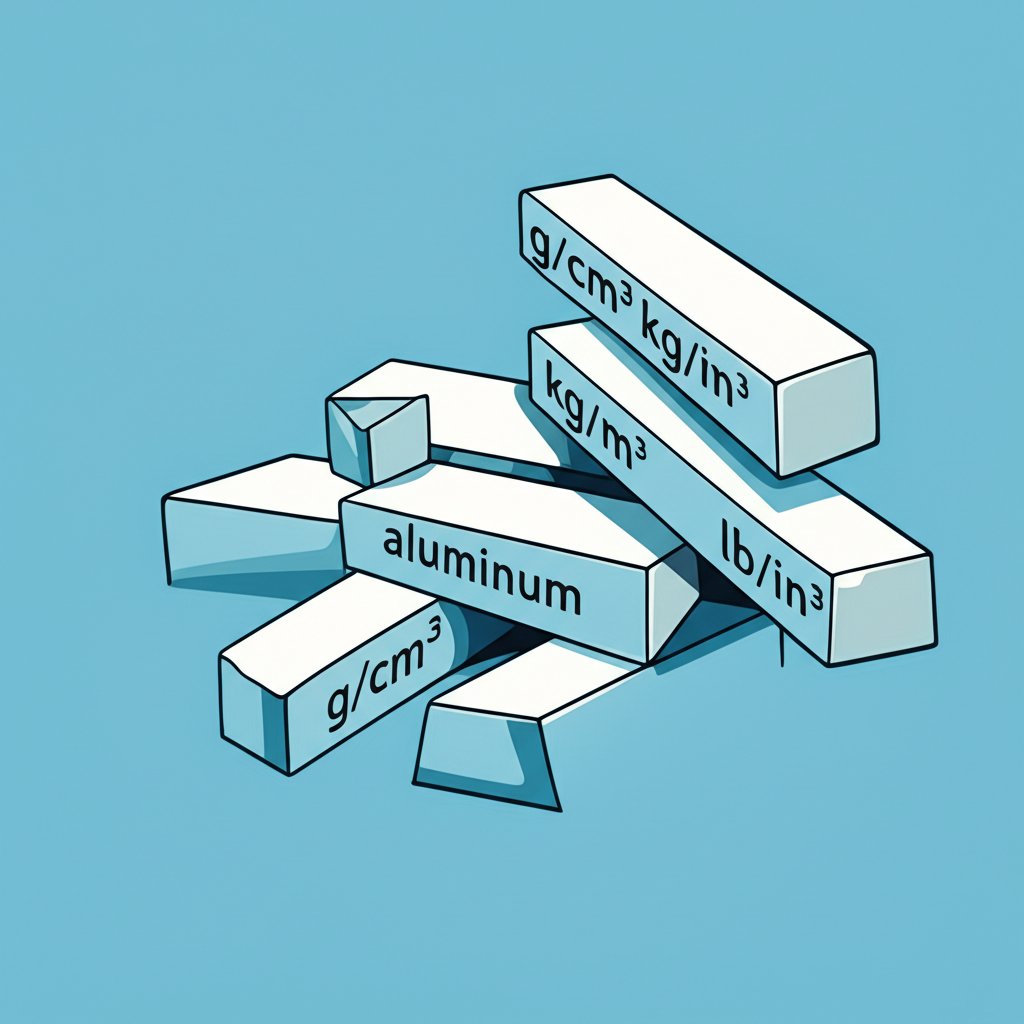
When you think about materials that are both strong and lightweight, what comes to mind? For many engineers, manufacturers, and designers, aluminum stands out—and for good reason. The secret behind aluminum’s versatility lies in its density, a property that influences everything from how easily a material can be moved to how efficiently it performs in demanding applications.
But what exactly is aluminum density? In simple terms, density is the measure of mass per unit volume. Imagine you’re holding two metal cubes of the same size—one aluminum and one steel. You’ll notice the aluminum cube feels much lighter. That’s because aluminum’s density is about one-third that of steel, making it a top choice for industries where reducing weight is crucial without sacrificing strength. This combination of lightness and durability has made aluminum indispensable in fields such as construction, transportation, aerospace, electronics, and even packaging (Kloeckner Metals).
So, why is understanding aluminum density so important? Here’s how this knowledge impacts real-world decisions:
Density is calculated using the straightforward formula:
Density (ρ) = Mass (m) / Volume (V)
This means you can determine how much mass is packed into a given space—critical for everything from structural beams to tiny electronic parts. For aluminum, the standard density is approximately 2,700 kg/m³ or 2.7 g/cm³, a value that remains consistent across most forms and is easy to reference using an aluminum density chart.
In this essential guide, you’ll learn:
Whether you’re designing the next generation of electric vehicles, optimizing energy-efficient buildings, or simply curious about material science, understanding aluminum density will empower you to make smarter decisions. As you continue reading, you’ll discover how this single property shapes the future of engineering and innovation.
When you pick up a piece of aluminum and wonder, “Why does this feel so light compared to other metals?”—you’re really asking, what is the density of aluminum? Understanding this property is fundamental in engineering, design, and everyday applications. Let’s break it down in clear, practical terms.
Simply put, density is the amount of mass packed into a given volume. In mathematical terms, it’s expressed as:
Density (ρ) = Mass (m) / Volume (V)
This means that if you know the mass and the volume of an aluminum object, you can calculate its density. For aluminum, this is a key property that sets it apart from other metals.
Pure aluminum, under standard conditions, has a density of about 2.7 grams per cubic centimeter (g/cm³) or 2,700 kilograms per cubic meter (kg/m³) (Sunrise Metal). These are the most common aluminum density units you’ll encounter in engineering charts and technical documents. For those working with imperial measurements, the value is typically noted as 0.1 pounds per cubic inch (lb/in³).
But here’s where it gets interesting: while pure aluminum’s density is remarkably consistent, the addition of other elements—creating what we call alloys—can tweak this value. For example, magnesium, silicon, copper, and zinc are often added to aluminum to enhance strength or corrosion resistance. These changes can shift the density of an alloy slightly higher or lower, usually ranging from about 2.63 g/cm³ to 2.81 g/cm³ depending on the specific composition (Kingsun Machining).
Understanding the density of aluminum isn’t just a trivia fact—it’s a practical tool for engineers, designers, and manufacturers. Here’s why:
Whether you’re designing a lightweight aircraft component, a durable building frame, or an energy-efficient electronic device, understanding aluminum density gives you the confidence to make informed decisions. In the next section, we’ll explore the exact benchmark values for pure aluminum and common alloys, making it even easier to apply this knowledge in real-world scenarios.

Ever wondered how engineers and designers quickly estimate the weight of a structure or component made from aluminum? It all starts with knowing the standard aluminum density values. These reference points are essential for calculations, comparisons, and material selection, making them a cornerstone of practical engineering.
For pure aluminum, the density remains remarkably consistent under standard conditions. This consistency is why aluminum is so widely trusted in both scientific and industrial settings. Here’s what you need to know:
These values are standardized and widely accepted in the industry (Sunrise Metal).
While pure aluminum is rarely used in its raw form, commercial-grade aluminum and its alloys exhibit only minor variations in density. The reason? Small amounts of alloying elements or impurities are added to enhance mechanical properties, but these tweaks don’t dramatically alter the overall density. Most commercial aluminum alloys fall within a narrow range:
For instance, the 1xxx series (nearly pure aluminum) is almost identical to pure aluminum in density, while certain 7xxx or 8xxx series alloys can approach the upper end of the range due to higher concentrations of zinc or other elements (Sunrise Metal).
| Type | g/cm³ | kg/m³ | lb/in³ |
|---|---|---|---|
| Pure Aluminum | 2.70 | 2,700 | 0.1 |
| Aluminum Alloys (Range) | 2.64–2.81 | 2,640–2,810 | ~0.098–0.102 |
Whether you’re referencing an aluminum density g/cm3 chart for laboratory work or calculating shipping weights with aluminum density kg m3 values, these benchmarks provide a reliable starting point.
Now that you know the standard values, let’s explore how these measurements are used across both imperial and metric systems—helping you choose the right unit for your next project.
When you’re working on U.S.-based projects or referencing American engineering standards, you’ll often encounter aluminum density lb/in3 as the go-to unit. But why is this measurement so common, and how does it affect your material choices?
Imagine you’re designing an aircraft part or an automotive panel—weight calculations aren’t just about numbers; they directly impact fuel efficiency, safety, and cost. In these industries, using density aluminum lb/in3 streamlines calculations because it aligns with other imperial measurements for length, area, and mass. This makes it easier to estimate the weight of complex assemblies or compare materials side-by-side without switching units.
The density of pure aluminum is remarkably consistent, and most alloys only vary slightly. Here’s a quick look at the standard values you’ll use most often (Tomorrow Al):
While these differences may seem small, they become significant when scaling up to large structures or when precise weight limits matter.
| Alloy | Density (lb/in³) |
|---|---|
| Pure Aluminum (1100) | 0.098 |
| 6061 | 0.098 |
| 7075 | 0.101 |
| 5052 | 0.097 |
Sounds complex? It’s actually straightforward when you consider the practical applications. Here are a few scenarios where knowing aluminum density in lb/in³ is crucial:
In summary, referencing aluminum density in lb/in³ makes it easy to perform weight calculations, select the right alloy, and optimize designs for American and global markets. Next, we’ll see how these values translate into the metric system, making international collaboration and scientific calculations just as seamless.
When you’re designing a bridge, calculating the load for a high-rise, or selecting materials for an electric vehicle, you’ll notice that most technical documents and engineering standards use the metric system. That’s why understanding the aluminum density metric—measured in kilograms per cubic meter (kg/m³)—is essential for professionals worldwide.
Ever wonder why “density of aluminum kg/m3” is the go-to value in so many applications? It’s simple: the metric system is universal in science and engineering, making calculations consistent and conversions straightforward. Whether you’re comparing materials, estimating shipping weights, or running simulations, using kg/m³ keeps your numbers precise and easy to communicate across borders and industries.
So, what’s the benchmark? Pure aluminum has a standard density of 2,700 kg/m³ under room temperature conditions (Sunrise Metal). But in real-world projects, you’re often working with alloys—aluminum blended with elements like magnesium, silicon, or copper to enhance properties such as strength or corrosion resistance.
These additions cause only slight shifts in density. Most commercial alloys fall within a narrow range, making it easy to estimate weights and plan designs without surprises. Here’s a quick breakdown:
For everyday engineering, simply multiplying the volume of your part (in cubic meters) by the appropriate density gives you an accurate weight—no need for complex conversions.
Sounds straightforward? Mostly, yes. But it’s worth noting that factors such as temperature, processing method, and the exact mix of alloying elements can nudge density values up or down. For instance:
| Material | Density (kg/m³) |
|---|---|
| Pure Aluminum | 2,700 |
| Common Alloys (Range) | 2,640 – 2,810 |
| 1xxx Series | ~2,700 |
| 7xxx Series (High Zn) | Up to 2,900 |
In summary, using aluminum density in kg/m³ streamlines your calculations, supports global collaboration, and ensures you’re working from a reliable, standardized foundation. Next, we’ll zoom in on a specific alloy—6061—and see how its density shapes its widespread use in modern engineering.

When you’re searching for an aluminum alloy that delivers strength, versatility, and reliability, 6061 aluminum often tops the list. But what makes this alloy so popular in everything from skyscraper frames to bicycle parts? The answer starts with its density—a property that’s nearly identical to pure aluminum, yet paired with mechanical advantages that make it a staple in modern engineering.
Imagine you’re designing a product that needs to be both lightweight and strong. 6061 aluminum, sometimes called “structural aluminum,” is renowned for its medium-to-high strength, excellent corrosion resistance, and outstanding workability (Gabrian). Its unique balance of properties comes from its chemical composition—mainly aluminum, magnesium, and silicon—which is carefully controlled to optimize performance.
So, how does the density of 6061 aluminum compare to pure aluminum? You’ll find that it’s remarkably close—typically around 2.70 g/cm³ (or 2,700 kg/m³). This means you get the lightweight benefits of pure aluminum with the added mechanical strength from alloying elements. For engineers, this density simplifies calculations and ensures that weight savings don’t come at the expense of durability (Wikipedia).
| Material | Density (g/cm³) | Density (kg/m³) |
|---|---|---|
| Pure Aluminum | 2.70 | 2,700 |
| 6061 Aluminum | 2.70 | 2,700 |
Because the aluminum density 6061 is so close to pure aluminum, you can confidently use standard density values for most calculations involving 6061 alloy. This consistency is a key reason why 6061 is the go-to choice for structural components, transportation frames, consumer electronics, and more.
Sounds straightforward? Let’s see how this plays out in real-world projects. Consider the following scenarios:
When you’re estimating the weight of a part or structure, simply multiply the volume by the standard density of 2.70 g/cm³ (or 2,700 kg/m³). Need a quick conversion for U.S. projects? That’s about 0.098 lb/in³—making international collaboration and supply chain management seamless.
Of course, the real power of 6061 aluminum comes from how it’s shaped and finished to meet specific application needs. That’s where advanced extrusion and processing capabilities make a difference. For example, Shengxin Aluminum offers a comprehensive suite of services for custom 6061 profiles, including:
Imagine designing a custom curtain wall system, a rail transit component, or a next-generation electric vehicle chassis—Shengxin’s expertise in 6061 aluminum ensures you get profiles that meet strict technical and aesthetic requirements, delivered on time and on budget.
In summary, understanding the density of 6061 aluminum unlocks its full potential across construction, transportation, and industrial design. Next, we’ll take a closer look at the 6061-T6 temper—where heat treatment further enhances strength, while density remains reliably consistent.
When you see the designation “6061-T6” on an engineering drawing or materials list, what exactly does it mean for density and performance? Let’s break it down so you can make informed choices for your next project—whether you’re building a lightweight vehicle frame or a high-strength rail component.
Sounds technical? It’s actually straightforward. The “T6” temper in 6061-T6 aluminum refers to a two-step heat treatment process:
This process transforms 6061 aluminum into one of the most versatile and reliable materials for demanding structural applications. But here’s the key takeaway: while the T6 temper dramatically improves mechanical properties, it does not significantly change the alloy’s density.
So, what is the aluminum 6061 t6 density? According to authoritative materials data (MatWeb ASM Material Data Sheet):
These values are nearly identical to those of pure aluminum and standard 6061 alloy, making calculations simple and reliable. In other words, the T6 temper boosts strength but keeps the density aluminum 6061 t6 right where you expect it—perfect for designs where weight and performance must be tightly controlled.
Imagine you’re tasked with designing a lightweight yet durable frame for a new energy vehicle, or a precision component for a rail transit system. Here’s why 6061-T6 is often the first choice:
When it comes to sourcing 6061-T6 profiles tailored for critical applications, manufacturing expertise makes all the difference. Shengxin Aluminum stands out with advanced extrusion lines (up to 5,500 tons), state-of-the-art surface finishing, and deep processing capabilities. Their track record includes supplying high-precision 6061-T6 profiles for:
With ISO-certified quality, rapid delivery, and flexible production, Shengxin ensures your 6061-T6 aluminum components meet the highest standards—no matter how complex or large-scale your project.
Ready to see how 6061-T6 aluminum density shapes the future of high-strength, lightweight engineering? Next, we’ll compare it to another powerhouse alloy—7075—and explore how subtle changes in composition influence both density and performance.
When you need a material that pushes the boundaries of strength without adding unnecessary weight, 7075 aluminum often tops the list. But what makes this alloy unique, and how does its density compare to the widely used 6061? Let’s break it down so you can make smart, informed choices for your next engineering challenge.
Imagine you’re designing a critical aircraft component or a high-performance racing part. You want a material that’s light, yet nearly as strong as steel. That’s where 7075 aluminum shines. Its secret? A high proportion of zinc (typically 5–6%) as the primary alloying element, along with magnesium and copper. This composition delivers exceptional strength and toughness, making 7075 a favorite for demanding, high-stress applications (Ryerson).
You might wonder, "Does all that extra strength come with a big jump in weight?" The answer is: only slightly. The 7075 aluminum density is about 2.81 g/cm³ (or 0.098–0.102 lb/in³), compared to 6061’s 2.70 g/cm³ (or 0.0975 lb/in³) (Kloeckner Metals). That’s a small increase, considering the significant boost in mechanical performance.
| Alloy | Density (g/cm³) | Density (lb/in³) | Typical Use Case |
|---|---|---|---|
| 6061 | 2.70 | 0.0975 | General structural, automotive, marine |
| 7075 | 2.81 | 0.098–0.102 | Aerospace, defense, high-performance sporting goods |
So, in an aluminum density comparison, 7075 is only about 4% denser than 6061. Yet, its tensile and yield strengths are nearly double, making it a go-to alloy where every gram of weight must deliver maximum performance (Wellste).
Let’s put numbers into perspective. The strength-to-weight ratio for 7075 is approximately 186 MPa/g/cm³, compared to 6061’s 102 MPa/g/cm³. This means 7075 can handle much higher stresses relative to its mass—crucial for aerospace frames, racing bike components, and military hardware that must perform under pressure without unnecessary bulk (Wellste).
Sounds impressive, but remember: 7075’s high density and strength come with trade-offs. It’s less corrosion-resistant and more challenging to weld or form than 6061. That’s why it’s reserved for applications where strength is the top priority and where extra processing costs are justified by performance gains.
In summary, 7075 aluminum alloy offers a slightly higher density than 6061, but delivers unmatched strength-to-weight advantages for the world’s most demanding engineering applications. Next, we’ll see how aluminum’s properties change even more dramatically when you shift from the metal to its oxide form—revealing a whole new set of uses and characteristics.

When you hear “aluminum,” you might picture a lightweight metal used in cans, car parts, or window frames. But what happens when aluminum reacts with oxygen? It transforms into aluminum oxide (Al2O3), a ceramic material with properties—and a density—vastly different from the metal itself. So, what’s the story behind aluminum oxide density, and why does this matter for engineers, manufacturers, and anyone working with advanced materials?
Let’s start with the numbers. If you’ve our discussion on metallic aluminum, you know its density is about 2.70 g/cm³. But aluminum oxide? It’s much denser, clocking in at 3.95–4.1 g/cm³ (Stanford Advanced Materials). That’s a jump of nearly 50%. Why so different? The answer lies in chemistry: aluminum oxide forms a tightly packed crystalline structure (corundum), which packs more mass into the same volume compared to the looser atomic arrangement of metallic aluminum.
Imagine you’re choosing between aluminum and aluminum oxide for a specific task. Here’s where their differences really matter:
| Property | Aluminum (Metal) | Aluminum Oxide (Al2O3) |
|---|---|---|
| Density (g/cm³) | 2.70 | 3.95–4.1 |
| Chemical Nature | Metal | Ceramic (oxide) |
| Electrical Conductivity | Excellent | Excellent Insulator |
| Hardness (Mohs) | 2.75 | 9 (second only to diamond) |
| Typical Uses | Construction, transportation, packaging, electronics | Abrasives, insulators, medical implants, protective coatings, ceramics |
Picture two scenarios: You’re designing a lightweight aircraft frame—aluminum’s low density is perfect. But if you need a scratch-resistant watch crystal or a high-temperature insulator, aluminum oxide is the clear winner. The higher aluminum oxide density means more mass and hardness per unit volume, which is essential for wear resistance and stability in harsh environments.
In summary, understanding aluminum vs aluminum oxide is more than just a numbers game—it’s about choosing the right material for the job. Their contrasting densities and properties open up a world of possibilities, from lightweight engineering marvels to ultra-hard surfaces and advanced ceramics. Next, we’ll wrap up with a summary of key insights and how to apply this knowledge to your own projects.

When you look back at the journey through aluminum density, one thing becomes clear: this single property unlocks a world of engineering possibilities. Whether you’re designing a lightweight bridge, an energy-efficient vehicle, or a next-generation electronics enclosure, understanding the nuances of aluminum density is the first step toward smarter material choices.
Sounds complex? It doesn’t have to be. By mastering the basics of aluminum density for engineering, you empower yourself to:
Imagine the competitive edge you’ll gain by applying this knowledge to every project—making data-driven decisions that deliver better outcomes for your team and your clients.
Of course, turning these insights into real-world success often means working with the right manufacturing partner. Shengxin Aluminum stands out as a leader in custom aluminum profiles, offering advanced extrusion, finishing, and deep processing capabilities for both standard and specialized alloys. Their commitment to quality, innovation, and flexible production ensures that your custom aluminum profiles meet even the most demanding technical and aesthetic requirements—whether you’re building for rail transit, new energy vehicles, or architectural masterpieces.
Ready to leverage the full potential of aluminum density in your next project? Use these insights as your foundation, and consider partnering with experts like Shengxin Aluminum for engineered solutions that deliver on every level. Your next innovation starts with the right material—and the right knowledge—to bring it to life.
Aluminum typically has a density of about 0.1 lb/in³. This lightweight nature makes it ideal for applications in aerospace, automotive, and construction where weight reduction is crucial for performance and efficiency.
The density of aluminum is approximately 2.70 g/cm³. This value is consistent for pure aluminum and only varies slightly among common alloys, supporting accurate calculations for engineering and manufacturing.
A 1 inch cube of aluminum weighs about 0.0975 pounds. This calculation uses the standard density of aluminum, helping engineers estimate the weight of parts and components quickly.
Aluminum’s atomic structure results in a lower mass per unit volume compared to metals like steel. This makes aluminum lighter, which is why it is commonly chosen for applications where reducing weight is a priority, such as in transportation and electronics.
6061 aluminum alloy has a density close to pure aluminum (about 2.70 g/cm³), while 7075 alloy is slightly denser at around 2.81 g/cm³. The small increase in 7075’s density is offset by its much higher strength, making it suitable for high-performance uses.
 Інтернет-сервіс
Інтернет-сервіс 0086 136 3563 2360
0086 136 3563 2360 sales@sxalu.com
sales@sxalu.com +86 136 3563 2360
+86 136 3563 2360